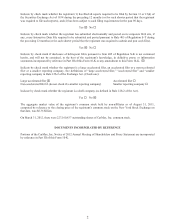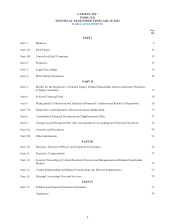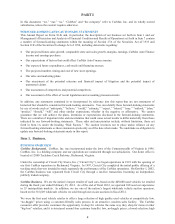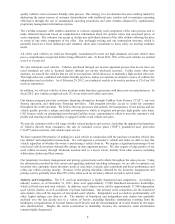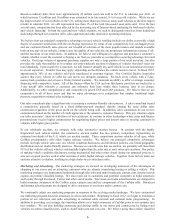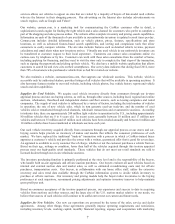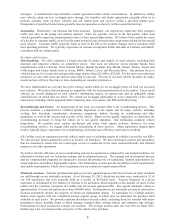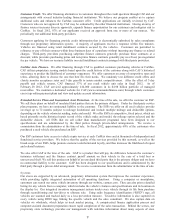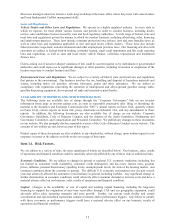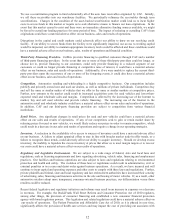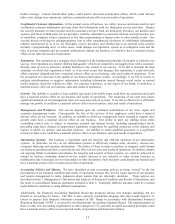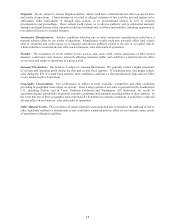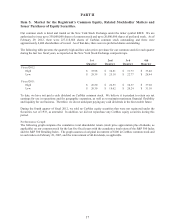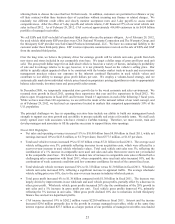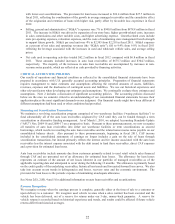CarMax 2012 Annual Report Download - page 18
Download and view the complete annual report
Please find page 18 of the 2012 CarMax annual report below. You can navigate through the pages in the report by either clicking on the pages listed below, or by using the keyword search tool below to find specific information within the annual report.12
We use a securitization program to fund substantially all of the auto loan receivables originated by CAF. Initially,
we sell these receivables into our warehouse facilities. We periodically refinance the receivables through term
securitizations. Changes in the condition of the asset-backed securitization market could lead us to incur higher
costs to access funds in this market or require us to seek alternative means to finance our loan originations. In the
event that this market ceased to exist and there were no immediate alternative funding sources available, we might
be forced to curtail our lending practices for some period of time. The impact of reducing or curtailing CAF’s loan
originations could have a material adverse effect on our business, sales and results of operations.
Disruptions in the capital and credit markets could adversely affect our ability to draw on our revolving credit
facility. If our ability to secure funds from the facility were significantly impaired, our access to working capital
would be impacted, our ability to maintain appropriate inventory levels could be affected and these conditions could
have a material adverse effect on our business, sales, results of operations and financial condition.
Third-Party Financing Providers. CarMax provides financing to qualified customers through CAF and a number
of third-party financing providers. In the event that one or more of these third-party providers could no longer, or
choose not to, provide financing to our customers, could only provide financing to a reduced segment of our
customers or could no longer provide financing at competitive rates of interest, it could have a material adverse
effect on our business, sales and results of operations. Additionally, if we were unable to replace the current third-
party providers upon the occurrence of one or more of the foregoing events, it could also have a material adverse
effect on our business, sales and results of operations.
Competition. Automotive retailing and wholesaling is a highly competitive business. Our competition includes
publicly and privately owned new and used car dealers, as well as millions of private individuals. Competitors buy
and sell the same or similar makes of vehicles that we offer in the same or similar markets at competitive prices.
Further, new entrants to the market could result in increased acquisition costs for used vehicles and lower-than-
expected retail and wholesale sales and margins. Competition is affected by the increasing use of the Internet to
market, buy and sell used vehicles and provide vehicle financing. The increasing use of the Internet in the
automotive retail and wholesale industry could have a material adverse effect on our sales and results of operations.
In addition, CAF and our third-party financing providers are subject to competition from various financial
institutions.
Retail Prices. Any significant changes in retail prices for used and new vehicles could have a material adverse
effect on our sales and results of operations. If any of our competitors seek to gain or retain market share by
reducing prices for used or new vehicles, we would likely reduce our prices in order to remain competitive, which
could result in a decrease in our sales and results of operations and require a change in our operating strategies.
Inventory. A reduction in the availability of or access to sources of inventory could have a material adverse effect
on our business. A failure to adjust appraisal offers to stay in line with broader market trade-in offer trends, or a
failure to recognize those trends, could adversely affect our ability to acquire inventory. Should we develop excess
inventory, the inability to liquidate the excess inventory at prices that allow us to meet margin targets or to recover
our costs could have a material adverse effect on our results of operations.
Regulatory and Legislative Environment. We are subject to a wide range of federal, state and local laws and
regulations, such as licensing requirements and laws regarding advertising, vehicle sales, financing and employment
practices. Our facilities and business operations are also subject to laws and regulations relating to environmental
protection and health and safety. The violation of these laws or regulations could result in administrative, civil or
criminal penalties or in a cease-and-desist order against business operations. As a result, we have incurred and will
continue to incur capital and operating expenses and other costs to comply with these laws and regulations. Further,
private plaintiffs and federal, state and local regulatory and law enforcement authorities have increased their scrutiny
of advertising, sales, financing and insurance activities in the sale and leasing of motor vehicles. If, as a result, other
automotive retailers adopt more transparent, consumer-oriented business practices, our differentiation versus those
retailers could be reduced.
Recent federal legislative and regulatory initiatives and reforms may result in an increase in expenses or a decrease
in revenues. For example, the Dodd-Frank Wall Street Reform and Consumer Protection Act of 2010 regulates,
among other things, the provision of consumer financing and established a new consumer financial protection
agency with broad regulatory powers. This legislation and related regulation could have a material adverse effect on
our results of operations. The Patient Protection and Affordable Care Act of 2010, as it is phased in over time,
significantly affects the provision of health care services and may impact the cost of providing our associates with


